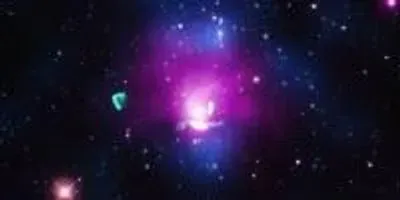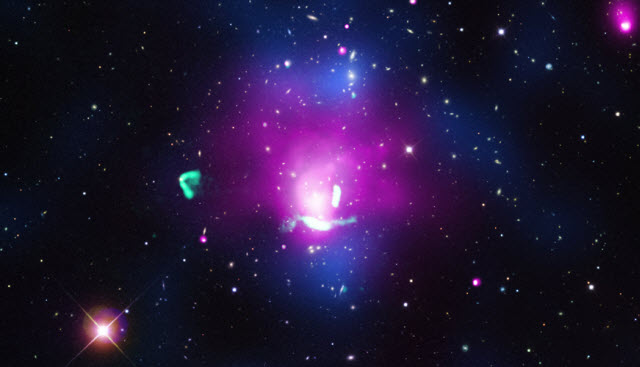Astronomers have found evidence for a faded electron cloud “coming back to life,” much like the mythical phoenix, after two galaxy clusters collided.


Evidence shows faded electron cloud "coming back to life"
Astronomers have found evidence for a faded electron cloud “coming back to life,” much like the mythical phoenix, after two galaxy clusters collided.

 The merging galaxy cluster Abell 1033. As the gravitationally bound cluster galaxies collided, the X-ray emitting intra-cluster plasma (pink) was stripped from each cluster and remains between the two clusters. During this process, a collision plasma shock was formed. As this shock passed through a population of relativistic particles, it re-excited them and they began to emit in the radio (light green downward facing bow shape) thus being dubbed a 'radio phoenix.'Image courtesy of NASA/CXC/University of Hamburg/F. de Gasperin et al, SDSS and NRAO/VLAAstronomers have found evidence for a faded electron cloud “coming back to life,” much like the mythical phoenix, after two galaxy clusters collided.
The merging galaxy cluster Abell 1033. As the gravitationally bound cluster galaxies collided, the X-ray emitting intra-cluster plasma (pink) was stripped from each cluster and remains between the two clusters. During this process, a collision plasma shock was formed. As this shock passed through a population of relativistic particles, it re-excited them and they began to emit in the radio (light green downward facing bow shape) thus being dubbed a 'radio phoenix.'Image courtesy of NASA/CXC/University of Hamburg/F. de Gasperin et al, SDSS and NRAO/VLAAstronomers have found evidence for a faded electron cloud “coming back to life,” much like the mythical phoenix, after two galaxy clusters collided.
This “radio phoenix,” so-called because the high-energy electrons radiate primarily at radio frequencies, is found in Abell 1033. The system is located about 1.6 billion light years from Earth.
By combining data from NASA’s Chandra X-ray Observatory, the Westerbork Synthesis Radio Telescope in the Netherlands, NSF’s Karl Jansky Very Large Array (VLA) and the Sloan Digital Sky Survey (SDSS), astronomers were able to re-create the scientific account behind the cosmic story of the radio phoenix.
Galaxy clusters are the largest structures in the universe held together by gravity. They consist of hundreds or even thousands of individual galaxies, unseen dark matter and huge reservoirs of hot gas that glow in X-ray light. Understanding how clusters grow is critical to tracking how the universe evolves over time.
Lawrence Livermore scientist Will Dawson mapped the galaxy distribution and performed the merger dynamics analysis. “This provided evidence that we were dealing with a major cluster merger (i.e., a merger between two large and relatively equal mass galaxy clusters) capable of generating a plasma shock, which could awaken the radio phoenix,” Dawson said.
Astronomers think that the supermassive black hole close to the center of Abell 1033 erupted in the past. Streams of high-energy electrons filled a region hundreds of thousands of light years across and produced a cloud of bright radio emission. This cloud faded over a period of millions of years as the electrons lost energy and the cloud expanded.
The radio phoenix emerged when another cluster of galaxies slammed into the original cluster, sending shock waves through the system. These shock waves, similar to sonic booms produced by supersonic jets, passed through the dormant cloud of electrons. The shock waves compressed the cloud and re-energized the electrons, which caused the cloud to once again shine at radio frequencies.
The Chandra data show hot gas in the clusters, which seems to have been disturbed during the same collision that caused the re-ignition of radio emission in the system. The peak of the X-ray emission is seen to the south of the cluster because the dense core of gas is being stripped away by surrounding gas as it moves. The cluster in the north may not have entered the collision with a dense core, or its core was significantly disrupted during the merger. On the left side of the image, a so-called wide-angle tail radio galaxy shines in the radio. The lobes of plasma ejected by the supermassive black hole in its center are bent by the interaction with the cluster gas as the galaxy moves through it.
Astronomers think they are seeing the radio phoenix soon after it was reborn, since these sources fade very quickly when located close to the center of the cluster, as in Abell 1033. Because of the intense density, pressure and magnetic fields near the center of Abell 1033, a radio phoenix is only expected to last a few tens of millions of years.
The research appears in a recent issue of the Monthly Notices of the Royal Astronomical Society. The authors are Francesco de Gasperin from the University of Hamburg, Germany; Georgiana Ogrean and Reinout van Weeren from the Harvard-Smithsonian Center for Astrophysics; Dawson from the Lawrence Livermore National Laboratory; Marcus Brüggen and Annalisa Bonafede from the University of Hamburg, Germany, and Aurora Simionescu from the Japan Aerospace Exploration Agency in Sagamihara.